Gaboon Viper vs Puff Adder: The Differences Between Two Venomous Snakes
#mobileSnakeQuizControls { overflow: hidden; text-overflow: ellipsis; white-space: nowrap; }
@media (min-width: 481px) {
.mobile-top-content {
display: none;
}
}
#mobileTopContentCTACarouselControls { overflow: hidden; text-overflow: ellipsis; white-space: nowrap; }
.mobile-top-content .more { color: #fff; }
.mobile-top-content a { color: #fff; text-decoration: underline; }
.mobile-top-content a:hover { color: #fff; text-decoration: underline; }
@media (max-width: 480px) {
.mobile-top-content {
background-color: #06a10b;
color: #fff;
text-align: center;
/*height: 60px;
padding-top:5px;*/
font-size:80%;
/* display: block; */
margin: 0px -30px;
}
}
Africa is home to some of the scariest snakes around. Some of the most venomous snakes on the planet live on the continent, and people are bitten quite often. Two of the most famous vipers that live in Africa are the Gaboon viper and the puff adder, but what makes them different? Today, we are going to compare the Gaboon viper vs puff adder and discover what makes them so unique. Let’s get started!
Comparing a Gaboon Viper and a Puff Adder
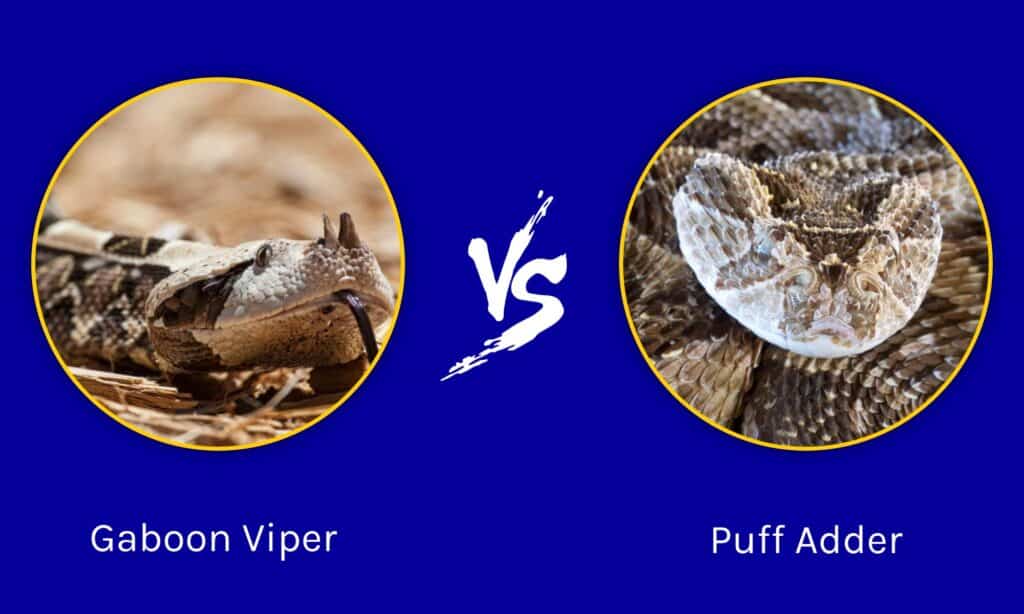
A-Z-Animals.com
| Gaboon viper | Puff adder | |
|---|---|---|
| Fang length | 2 inches | .7 inches |
| Venom yield | Highest of any snake, up to 1000 mg total. | Generally 150-350. |
| Distribution | Central Africa. Rainforest and woodlands. | Most common snake in Africa. Almost all of sub-Saharan Africa. |
| Color and patterning | Pale, rectangular blotches down the center back, separated by darker brown hourglass markings. Pale bellies with occasional blotches and a cream head with a central line. | Varies based on location. Generally has 18-22 backward directed bands that alternate between brown and light brown or tan. Yellow or white belly. |
| Venom strength | Bites are rare, deaths are even rarer. Second largest venom injection of any snake. | Most deadly snake in Africa by the numbers. |
The 5 main differences between a Gaboon viper and a puff adder
The main difference between a Gaboon viper and a puff adder is that Gaboon vipers only live in the rainforests of central Africa, have higher venom yields than any other snake, and aren’t as deadly as puff adders. Additionally, puff adders are much more common and live in places where humans often travel.
button.pulse {
transform: scale(1); animation: pulse 2s infinite;
box-shadow: 0 0 0 0 rgba(11, 247, 25, 1);
}
@keyframes pulse {
0% { transform: scale(0.90); box-shadow: 0 0 0 0 rgba(11, 247, 25, 0.5); }
60% { transform: scale(1); box-shadow: 0 0 0 15px rgba(11, 247, 25, 0); }
100% { transform: scale(0.90); box-shadow: 0 0 0 0 rgba(11, 247, 25, 0); }
}
Gaboon vipers and puff adders are both members of the Viperidae family, meaning they are vipers. All vipers are venomous, and these two snakes are no exception. Both the Gaboon viper and the puff adder are capable of delivering a dangerous venom injection, although the puff adder has a much more toxic venom than the Gaboon viper. Additionally, the Gaboon viper is recognized as having the largest venom yield of any snake on earth.
Although these snakes look similar, Gaboon vipers are generally larger and have large alternating bands of brown and light brown (similar to a copperhead). Puff adders are smaller and have up to 22 bands on their backs that look like chevrons pointing towards their tails.
Let’s take a deeper look at these differences between the two, plus learn a bit more about them.
Gaboon Viper vs Puff Adder: Fang length
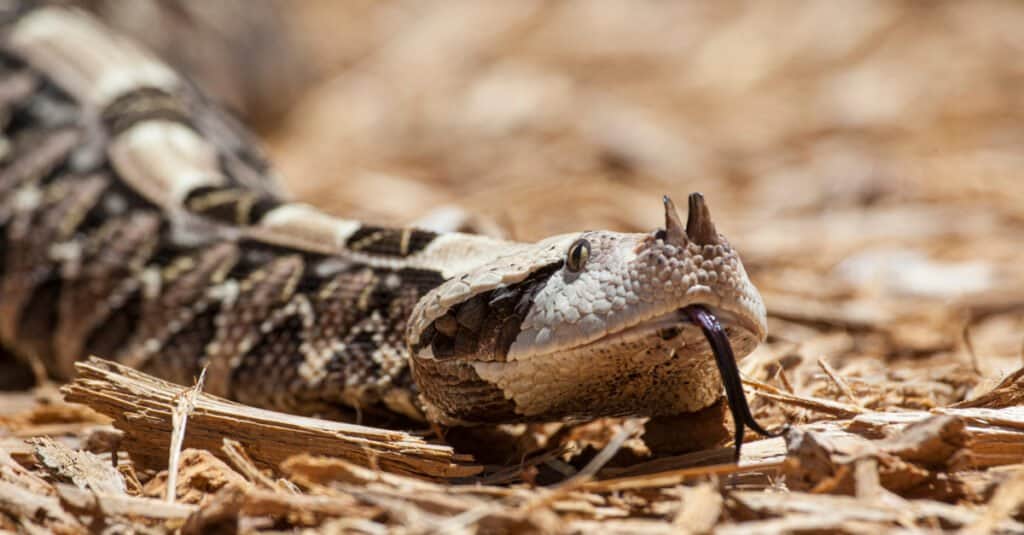
Danita Delimont/Shutterstock.com
When it comes to fang length, the Gaboon viper is the clear winner. In fact, these snakes have the largest fangs of any venomous snake in the world, coming in at 2 inches on average. Their fangs are hinged and fold out when they open their mouths. As we will soon see, the Gaboon viper is number one in a lot of other categories! With such large fangs, these vipers are able to inject venom deep into their prey, making it more effective.
The puff adder has substantial fangs of its own, but nothing compared to the Gaboon viper. Most puff adders have fangs that average at .7 inches, less than half of that of the Gaboon. Still, these snakes are able to deliver deadly bites to prey and humans alike, even with shorter fangs.
Gaboon Viper vs Puff Adder: Venom yield
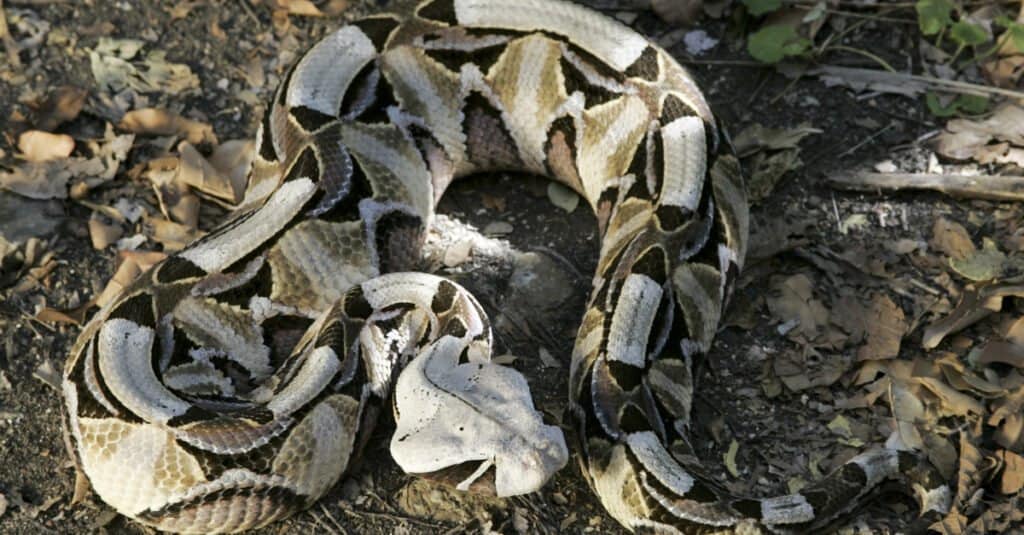
Stu Porter/Shutterstock.com
Venom yield is a measurement of how much venom a snake has at its disposal. The Gaboon viper holds the record for the highest venom yield of any snake in the world. The venom glands are so large that they can actually be seen under the skin on each side of the snake’s head, giving it a distinctly wide and triangular head. Gaboon vipers have a venom yield that can reach 1000 mg dry.
The puff adder has extremely dangerous venom but doesn’t have the same amount as the Gaboon viper does. In fact, the puff adder has a deadlier venom, so it doesn’t need nearly as much of it stored in their bodies. On average, a puff adder has a venom yield of around 150-350 mg, but they have been recorded in some situations with a yield as high as 750 mg.
Gaboon Viper vs Puff Adder: Distribution
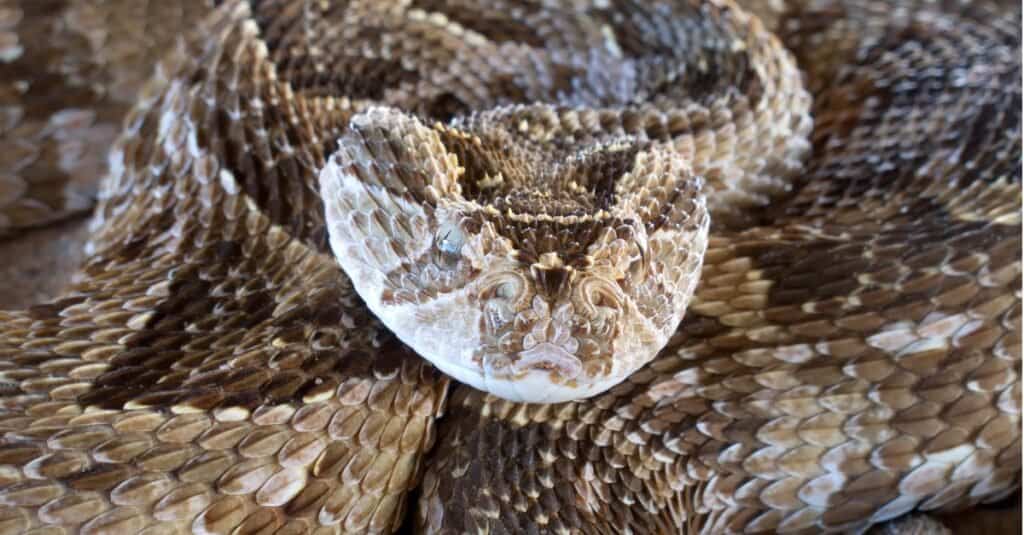
iStock.com/EcoPic
The Gaboon viper exclusively lives in rainforest and woodland settings. As a result, their native range in Africa is generally going to be around the middle of the continent, where this habitat is more prevalent. The Gaboon viper can be found in Guinea, Ghana, Togo, Nigeria, Cameroon, Equatorial Guinea, Gabon, the Republic of the Congo, the DR Congo, northern Angola, the Central African Republic, South Sudan, Uganda, Kenya, eastern Tanzania, Zambia, Malawi, eastern Zimbabwe, Mozambique, and northeast KwaZulu-Natal Province in South Africa.
The puff adder is extremely widespread and holds the record as the most widespread venomous snake in Africa. They primarily live in sub-Saharan Africa, although they do have a population in the Middle East. The puff adder can be found in Morocco, Mauritania, Senegal, Mali, southern Algeria, Guinea, Sierra Leone, Côte d’Ivoire, Ghana, Togo, Benin, Niger, Nigeria, Chad, Sudan, Cameroon, the Central African Republic, northern, eastern, and southern Democratic Republic of the Congo, Uganda, Kenya, Somalia, Rwanda, Burundi, Tanzania, Angola, Zambia, Malawi, Mozambique, Zimbabwe, Botswana, Namibia, and South Africa. They can also be found in Saudi Arabia and Yemen.
Gaboon Viper vs Puff Adder: Color and patterning
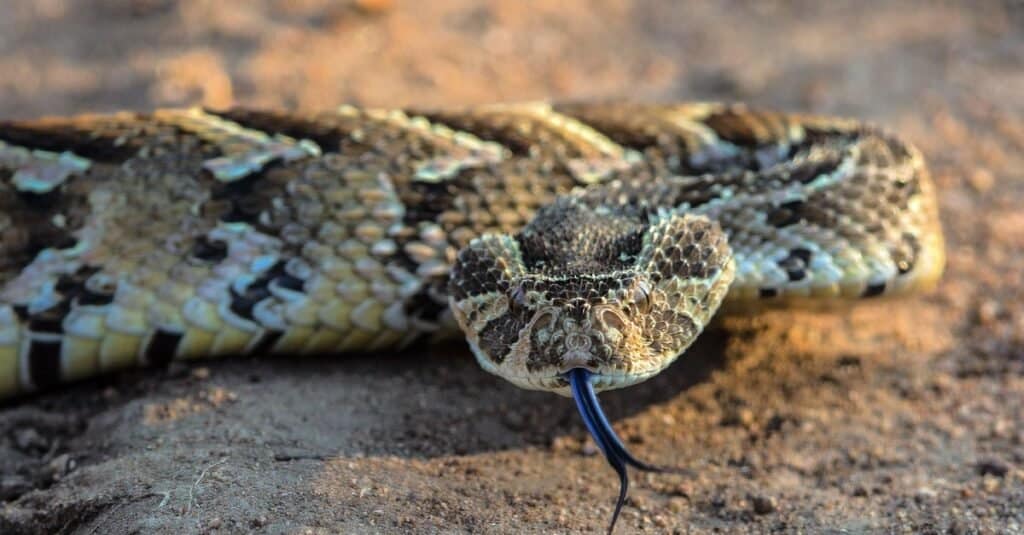
iStock.com/S_Lew
The Gaboon viper has a pattern that many in North America would recognize as similar to the copperhead. These snakes usually have large bands of alternating dark brown and tan down their bodies that enable them to hide in brush and on leaves. Their heads are large, flat, and triangular, with large lumps on either side where their venom glands reside.
The puff adder resembles a few species of North American rattlesnake in many ways. Their pattern varies depending on where they are found, but they generally have 18-22 backward-facing chevrons that alternate between dark brown or black and a lighter brown.
Gaboon Viper vs Puff Adder: Venom strength
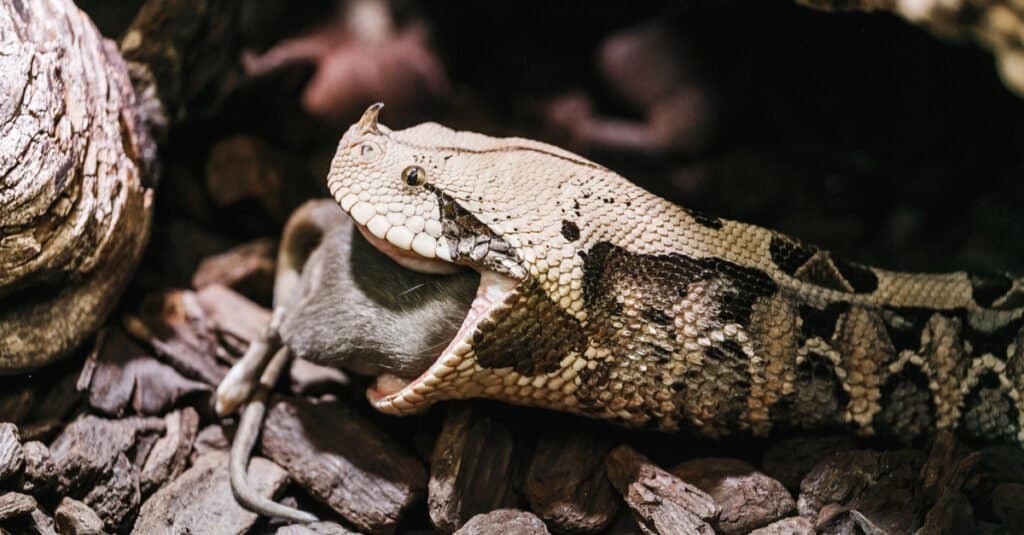
frantic00/Shutterstock.com
Although the Gaboon viper has massive fangs, the second most venom injected per bite, and the largest venom yield of any snake, they aren’t nearly as deadly as the puff adder is. It is likely that many of these features are a result of the fact that their venom isn’t as potent as other snakes, especially the puff adder. Bites from Gaboon vipers are extremely rare, and most people survive with the appropriate medical treatment.
The puff adder is known as the deadliest snake in Africa by the numbers. More people die from adders each year than any other snake. The first reason is that they are so prevalent and in close contact with humans. Footpaths, gardens, brush, and rocks are all places that adders like to hang out, and bites are common, especially when the snake isn’t seen. Additionally, puff adders have some of the most potent venom out of any viper species in Africa. The ranking system for snake venom toxicity is known as the LD50 , and the puff adder has venom that is 2-4x more toxic than Gaboon vipers. Reports vary, with some claiming a 15% mortality rate in untreated bites, while some claim a 52% mortality rate.
Discover the “Monster” Snake 5X Bigger than an Anaconda
Every day A-Z Animals sends out some of the most incredible facts in the world from our free newsletter. Want to discover the 10 most beautiful snakes in the world, a “snake island” where you’re never more than 3 feet from danger, or a “monster” snake 5X larger than an anaconda? Then sign up right now and you’ll start receiving our daily newsletter absolutely free.
More from A-Z Animals
.more-snake-card-image { max-height:140px !important; }
#mobileSnakeQuizControls { overflow: hidden; text-overflow: ellipsis; white-space: nowrap; }
@media (min-width: 481px) {
.mobile-top-content {
display: none;
}
}
#mobileTopContentCTACarouselControls { overflow: hidden; text-overflow: ellipsis; white-space: nowrap; }
.mobile-top-content .more { color: #fff; }
.mobile-top-content a { color: #fff; text-decoration: underline; }
.mobile-top-content a:hover { color: #fff; text-decoration: underline; }
@media (max-width: 480px) {
.mobile-top-content {
background-color: #06a10b;
color: #fff;
text-align: center;
/*height: 60px;
padding-top:5px;*/
font-size:80%;
/* display: block; */
margin: 0px -30px;
}
}
Africa is home to some of the scariest snakes around. Some of the most venomous snakes on the planet live on the continent, and people are bitten quite often. Two of the most famous vipers that live in Africa are the Gaboon viper and the puff adder, but what makes them different? Today, we are going to compare the Gaboon viper vs puff adder and discover what makes them so unique. Let’s get started!
Comparing a Gaboon Viper and a Puff Adder

A-Z-Animals.com
| Gaboon viper | Puff adder | |
|---|---|---|
| Fang length | 2 inches | .7 inches |
| Venom yield | Highest of any snake, up to 1000 mg total. | Generally 150-350. |
| Distribution | Central Africa. Rainforest and woodlands. | Most common snake in Africa. Almost all of sub-Saharan Africa. |
| Color and patterning | Pale, rectangular blotches down the center back, separated by darker brown hourglass markings. Pale bellies with occasional blotches and a cream head with a central line. | Varies based on location. Generally has 18-22 backward directed bands that alternate between brown and light brown or tan. Yellow or white belly. |
| Venom strength | Bites are rare, deaths are even rarer. Second largest venom injection of any snake. | Most deadly snake in Africa by the numbers. |
The 5 main differences between a Gaboon viper and a puff adder
The main difference between a Gaboon viper and a puff adder is that Gaboon vipers only live in the rainforests of central Africa, have higher venom yields than any other snake, and aren’t as deadly as puff adders. Additionally, puff adders are much more common and live in places where humans often travel.
button.pulse {
transform: scale(1); animation: pulse 2s infinite;
box-shadow: 0 0 0 0 rgba(11, 247, 25, 1);
}
@keyframes pulse {
0% { transform: scale(0.90); box-shadow: 0 0 0 0 rgba(11, 247, 25, 0.5); }
60% { transform: scale(1); box-shadow: 0 0 0 15px rgba(11, 247, 25, 0); }
100% { transform: scale(0.90); box-shadow: 0 0 0 0 rgba(11, 247, 25, 0); }
}
Gaboon vipers and puff adders are both members of the Viperidae family, meaning they are vipers. All vipers are venomous, and these two snakes are no exception. Both the Gaboon viper and the puff adder are capable of delivering a dangerous venom injection, although the puff adder has a much more toxic venom than the Gaboon viper. Additionally, the Gaboon viper is recognized as having the largest venom yield of any snake on earth.
Although these snakes look similar, Gaboon vipers are generally larger and have large alternating bands of brown and light brown (similar to a copperhead). Puff adders are smaller and have up to 22 bands on their backs that look like chevrons pointing towards their tails.
Let’s take a deeper look at these differences between the two, plus learn a bit more about them.
Gaboon Viper vs Puff Adder: Fang length

Danita Delimont/Shutterstock.com
When it comes to fang length, the Gaboon viper is the clear winner. In fact, these snakes have the largest fangs of any venomous snake in the world, coming in at 2 inches on average. Their fangs are hinged and fold out when they open their mouths. As we will soon see, the Gaboon viper is number one in a lot of other categories! With such large fangs, these vipers are able to inject venom deep into their prey, making it more effective.
The puff adder has substantial fangs of its own, but nothing compared to the Gaboon viper. Most puff adders have fangs that average at .7 inches, less than half of that of the Gaboon. Still, these snakes are able to deliver deadly bites to prey and humans alike, even with shorter fangs.
Gaboon Viper vs Puff Adder: Venom yield

Stu Porter/Shutterstock.com
Venom yield is a measurement of how much venom a snake has at its disposal. The Gaboon viper holds the record for the highest venom yield of any snake in the world. The venom glands are so large that they can actually be seen under the skin on each side of the snake’s head, giving it a distinctly wide and triangular head. Gaboon vipers have a venom yield that can reach 1000 mg dry.
The puff adder has extremely dangerous venom but doesn’t have the same amount as the Gaboon viper does. In fact, the puff adder has a deadlier venom, so it doesn’t need nearly as much of it stored in their bodies. On average, a puff adder has a venom yield of around 150-350 mg, but they have been recorded in some situations with a yield as high as 750 mg.
Gaboon Viper vs Puff Adder: Distribution

iStock.com/EcoPic
The Gaboon viper exclusively lives in rainforest and woodland settings. As a result, their native range in Africa is generally going to be around the middle of the continent, where this habitat is more prevalent. The Gaboon viper can be found in Guinea, Ghana, Togo, Nigeria, Cameroon, Equatorial Guinea, Gabon, the Republic of the Congo, the DR Congo, northern Angola, the Central African Republic, South Sudan, Uganda, Kenya, eastern Tanzania, Zambia, Malawi, eastern Zimbabwe, Mozambique, and northeast KwaZulu-Natal Province in South Africa.
The puff adder is extremely widespread and holds the record as the most widespread venomous snake in Africa. They primarily live in sub-Saharan Africa, although they do have a population in the Middle East. The puff adder can be found in Morocco, Mauritania, Senegal, Mali, southern Algeria, Guinea, Sierra Leone, Côte d’Ivoire, Ghana, Togo, Benin, Niger, Nigeria, Chad, Sudan, Cameroon, the Central African Republic, northern, eastern, and southern Democratic Republic of the Congo, Uganda, Kenya, Somalia, Rwanda, Burundi, Tanzania, Angola, Zambia, Malawi, Mozambique, Zimbabwe, Botswana, Namibia, and South Africa. They can also be found in Saudi Arabia and Yemen.
Gaboon Viper vs Puff Adder: Color and patterning

iStock.com/S_Lew
The Gaboon viper has a pattern that many in North America would recognize as similar to the copperhead. These snakes usually have large bands of alternating dark brown and tan down their bodies that enable them to hide in brush and on leaves. Their heads are large, flat, and triangular, with large lumps on either side where their venom glands reside.
The puff adder resembles a few species of North American rattlesnake in many ways. Their pattern varies depending on where they are found, but they generally have 18-22 backward-facing chevrons that alternate between dark brown or black and a lighter brown.
Gaboon Viper vs Puff Adder: Venom strength

frantic00/Shutterstock.com
Although the Gaboon viper has massive fangs, the second most venom injected per bite, and the largest venom yield of any snake, they aren’t nearly as deadly as the puff adder is. It is likely that many of these features are a result of the fact that their venom isn’t as potent as other snakes, especially the puff adder. Bites from Gaboon vipers are extremely rare, and most people survive with the appropriate medical treatment.
The puff adder is known as the deadliest snake in Africa by the numbers. More people die from adders each year than any other snake. The first reason is that they are so prevalent and in close contact with humans. Footpaths, gardens, brush, and rocks are all places that adders like to hang out, and bites are common, especially when the snake isn’t seen. Additionally, puff adders have some of the most potent venom out of any viper species in Africa. The ranking system for snake venom toxicity is known as the LD50 , and the puff adder has venom that is 2-4x more toxic than Gaboon vipers. Reports vary, with some claiming a 15% mortality rate in untreated bites, while some claim a 52% mortality rate.
Discover the “Monster” Snake 5X Bigger than an Anaconda
Every day A-Z Animals sends out some of the most incredible facts in the world from our free newsletter. Want to discover the 10 most beautiful snakes in the world, a “snake island” where you’re never more than 3 feet from danger, or a “monster” snake 5X larger than an anaconda? Then sign up right now and you’ll start receiving our daily newsletter absolutely free.







